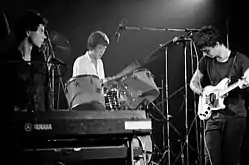Avant-funk
Avant-funk is a music style in which artists combine funk rhythms with an avant-garde or art rock mentality.[3] Its most prominent era occurred in the late 1970s among post-punk acts who embraced black dance styles.[4]
| Avant-funk | |
|---|---|
| Other names | Punk-funk[1] |
| Stylistic origins | |
| Cultural origins | 1960s, United Kingdom and United States |
| Derivative forms | House, drum and bass |
| Other topics | |
Characteristics
Critic Simon Reynolds described avant-funk as "difficult dance music" and a kind of psychedelia in which "oblivion was to be attained not through rising above the body, rather through immersion in the physical, self loss through animalism."[3] Simon Frith described avant-funk as an application of progressive rock mentality to rhythm rather than melody and harmony.[3]
Some motifs of the style in the 1970s and 1980s included "neurotic slap-bass" and "guttural pseudo-sinister vocals,"[1] as well as "Eurodisco rhythms; synthesizers used to generate not pristine, hygienic textures, but poisonous, noisome filth; Burroughs’ cut-up technique applied to found voices."[3] According to Reynolds, the movement was animated by the notion that "rock's hopes of enjoying a future beyond mere antiquarianism depends on assimilating the latest rhythmic innovations from black dance music."[1]
History

Early acts who have retrospectively been described with the term include German krautrock band Can,[5] American funk artists Sly Stone and George Clinton,[6] and jazz trumpeter Miles Davis.[7] Herbie Hancock's 1972 album Sextant was called an "uncompromising avant-funk masterpiece" by Paste.[8] Jazz saxophonist Ornette Coleman led the avant-funk band Prime Time in the 1970s and 1980s.[9] Guitarist James "Blood" Ulmer, who performed with Coleman in the 1970s, was described by The New Yorker as "one of avant-funk's masters."[10]
According to Reynolds, a pioneering wave of avant-funk artists came in the late 1970s, when post-punk artists (including Public Image Ltd, Liquid Liquid, and James Chance, as well as Cabaret Voltaire, Talking Heads, The Pop Group, DAF, A Certain Ratio, and 23 Skidoo)[11] embraced black dance music styles such as funk and disco.[4] Reynolds noted these artists' preoccupations with issues such as alienation, repression and the technocracy of Western modernity.[3] The all-female avant-funk group ESG formed in the Bronx during this era.[12] The artists of the late 1970s New York no wave scene also explored avant-funk, influenced by Ornette Coleman.[2]
Later groups such as Skinny Puppy, Chakk, 400 Blows represented later waves of the style. By the mid 1980s, it had dissipated, as white alternative groups turned away from the dancefloor[1] and many of its original practitioners instead became a part of the UK's first wave of house music,[11] including Cabaret Voltaire's Richard H. Kirk and Graham Massey of Biting Tongues (and later of 808 State).[1] Reynolds compared the UK's rave music and jungle scenes of the early 1990s to a "reactivation" of avant-funk, calling it "a populist vanguard, a lumpen bohemia that weirdly mashed together the bad-trippy sounds of art school funk-mutation with a plebeian pill-gobbling rapacity.[1] Avant-funk would go on to influence '90s drum and bass producers such as 4hero and A Guy Called Gerald.[13]
See also
References
- Reynolds, Simon (2001). "Dancing on the Edge". Index.
- Murray, Charles Shaar (October 1991). Crosstown Traffic: Jimi Hendrix & The Post-War Rock 'N' Roll Revolution. Macmillan. p. 205. ISBN 9780312063245. Retrieved 6 March 2017.
- Reynolds, Simon (February 13, 1987). "End of the Track". New Statesman.
- Reynolds, Simon (2006). Rip It Up and Start Again: Postpunk 1978-1984. Penguin. ISBN 9781101201053.
avant-funk sly stone.
- Reynolds, Simon (1995). "Krautrock Reissues". Melody Maker. Retrieved 5 March 2017.
- Staff (25 December 2004). "Passings". Billboard (116). Nielsen. Retrieved 5 March 2017.
- Gluckin, Tzvi. "Forgotten Heroes: Pete Cosey". Premier Guitar. Retrieved 27 April 2017.
- Jarnow, Jesse. "Herbie Hancock: Cafe Curiosity". Paste. Retrieved 1 August 2020.
- Russonello, Gionvanni. "Ornette Coleman's Innovations Are Celebrated at Lincoln Center". The New York Times. Retrieved 26 August 2020.
- Brody, Richard. "Ornette Coleman's Revolution". The New Yorker. Retrieved 26 August 2020.
- Reynolds, Simon (2012). Energy Flash: A Journey Through Rave Music and Dance Culture. Soft Skull Press. pp. 20, 202. ISBN 9781593764777. Retrieved 5 March 2017.
- Greenman, Ben. [artsbeat.blogs.nytimes.com/living-with-music-a-playlist-by-ben-greenman "Living with Music: A Playlist by Ben Greenman"] Check
|url=value (help). The New York Times. Retrieved 17 January 2021. - Staff (February 1995). "Return Of The Gerald". Mixmag (45).